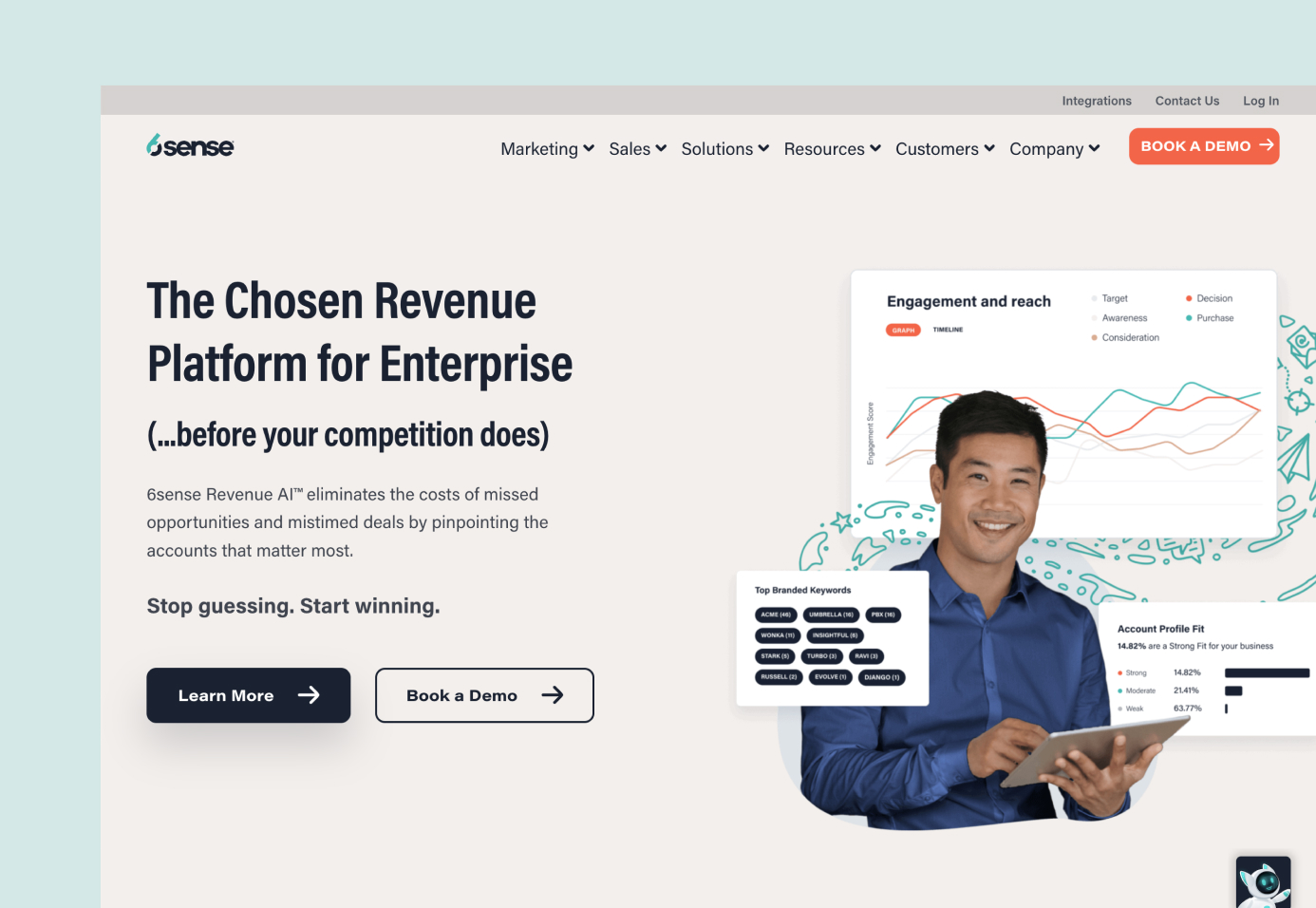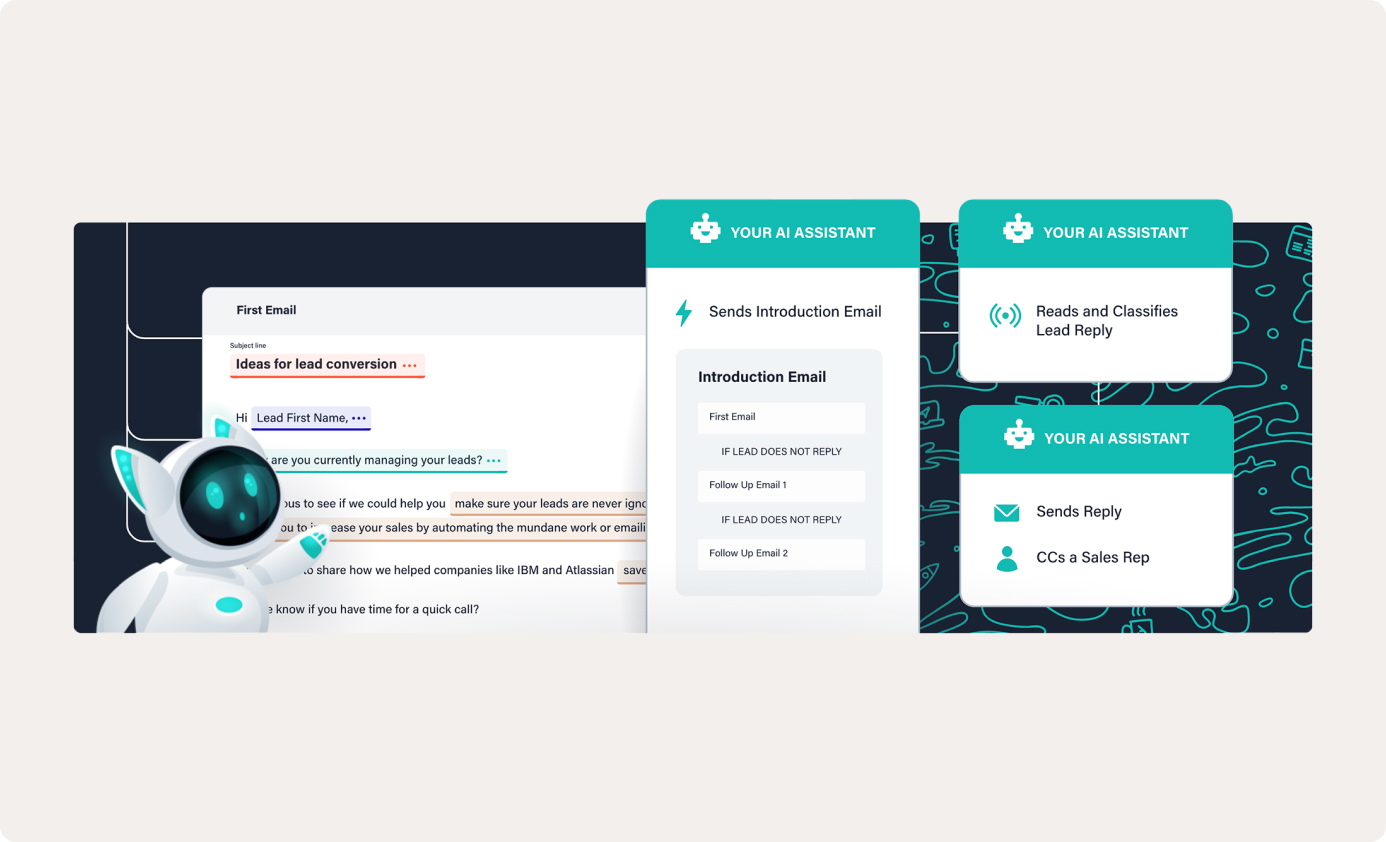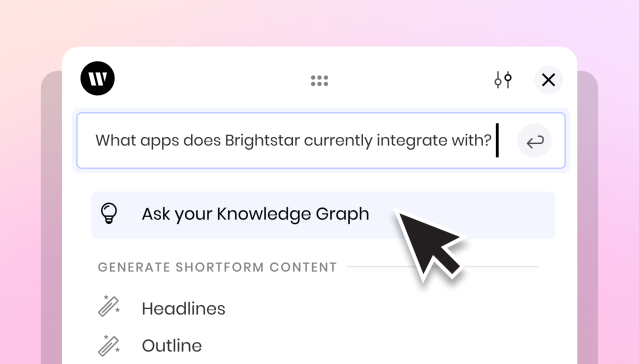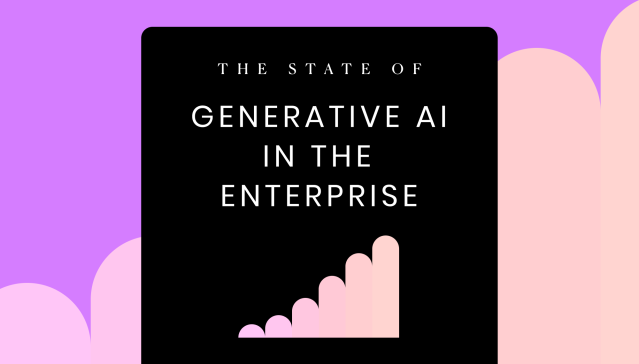- story – 11 min read
- AUDIO – 21 min
We have to reimagine
how we work
How 6sense marketing uses Writer to get more efficient

Listen to the 6sense story or read the (edited) transcript below
WRITER is the full-stack generative AI platform for enterprises. We make it easy for organizations to adopt AI apps and workflows that deliver quantifiable ROI quickly.
WRITER helps organizations build highly-customized AI apps that compress entire business processes, support complex use cases, and infuse work with company intelligence. Our enterprise-grade platform can be deployed flexibly, keeps your data private, and adheres to global privacy laws and security standards. Leading enterprises choose WRITER, including Vanguard, Intuit, Accenture, and Kenvue.
Latané Conant is chief market officer at 6sense and is passionate about empowering marketing leaders with effective technology, predictive insights, and thought leadership so they can confidently lead their teams, company, and industry into the future. Read or listen to the story of how Latané and team use WRITER to scale content, fuel growth, and reinforce the 6sense voice across every written asset.
Tell us about 6sense — the company’s value to its customers and how the brand has evolved.
6sense is a really interesting company whose entire heritage is actually based in AI. The company was originally founded to answer one question: Wouldn’t B2B sales and marketing be so much easier if we just knew who was ready to buy? Kind of an easy question or basic question, but really, really, really hard to solve. And, in order to solve that, 6sense had to really understand data, particularly what we call “dark funnel” data. So that’s all the activity that people are doing on your website before they’re filling out a form. It’s the research that they’re doing about you and your competitors. It’s keyword research they’re doing about the problems that they have. And so being able to bring all of that dark funnel data together with all of the company’s first party data allowed us to answer that big question and be able to tell people who’s ready to buy.
Fast forward to today, and we answer a lot of other questions that we think are the most critical questions for B2B sales and marketing teams: Who’s ready to buy? Are they the right fit account for you? Who’s on the buying team? Who should you call? What contact data should you use? What channel works the best? So, it’s all about answering these really critical questions to make sales and marketing teams a lot more efficient and effective.

Tell us about your organization and
management style.
I think that teams should always run scrappy. When I started at 6sense, there was one other marketer and we’ve had a great journey using our own product. We’ve been able to grow 100% for the last five years in a row. We’ve had this huge growth trajectory, all with an industry-leading customer acquisition cost (CAC). If I look at my team now, it’s a lot more than two marketers. It’s a pretty significantly-sized team. But when you think about scale, being a great company, and having great SaaS metrics, it’s all about being able to be more efficient every single year.
Tell us about some of your marketing initiatives.
For us at 6sense, we’ve been on this growth trajectory — on this tear, and we plan to continue to be on that growth trajectory and on that growth tear. We want to do it more and more efficiently. What we’re seeing with the market conditions is that to win a deal today versus a year ago is just harder. It takes more activities. When we look at the activity level, it’s about 50% more activity per deal. And also the buying team that we have to engage has doubled. It used to be six engaged personas on a deal that we win, and now it’s 13.
I’ve been thinking a lot about this challenge because we’ve got to grow, right? We’re on a growth tear. We’re going to continue to be on a growth tear. It takes more work to achieve that same level of growth. And we’ve challenged ourselves to keep our headcount flat because we want to be as efficient as possible. I call this B2B inflation. We started to hear this message, “Do more with less. Do more with less.” And I think that sucks. Like, I don’t want to do more with less. That sounds terrible! And when I hear that, what I hear is a more and more fried team.
Maybe that’s another weekend of work. Maybe that’s a couple more hours at night. And the reality is we have been working already as a team on this crazy growth — high-paced, you know, high-commitment level and everyone’s fried. And so we have to do more with less, yes. But I think we also have to change the way we work. And I came to this “aha” because I’m like, okay, we’re facing B2B inflation. It’s a lot harder to get deals done. Same amount of resources, same goals. We can’t lower our goals just because it’s harder.
“We’re facing B2B inflation… Same amount of resources, same goals. We can’t lower our goals just because it’s harder.”

Latané Conant
Chief Market Officer
You know, working another weekend or night — that’s a drop in the bucket. That’s not even gonna really solve the problem. And so for us, we had an “aha” and we said, you know what? We have got to reimagine how we work. We looked at the email space (and this was over two years ago), and we said no one has really revolutionized the content in the email. That’s where we think the next wave of innovation, of prospect experience, of ABM, of better sales and marketing, is going to come from. It’s gonna come from writing and being more personalized and being more relevant with email. We embarked on this journey two years ago, and last October launched a generative AI product that reads, writes, and responds to email.

I needed to reimagine the way we worked. And I’m looking around like, where is the lifeboat? This generative AI product that we launched was the first sign of a lifeboat. This can actually be amazing, and it can be high quality, and it can actually be better and enhance the customer or the prospect experience because customers and prospects and people, we want to interact. So, taking the emailing back and forth and finding a convenient time and making sure the right attachment is on emails and looping people in — we don’t need humans to do that! It was just this really profound moment. That’s when I went to my team and I huddled everyone together and I said we have a new mantra: we are not doing more.
We need to be the antidote to more. And so we set some pretty big goals around reimagining how we work, and a big part of reimagining how we work was infusing generative AI.
What’s been particularly interesting is we’ve found that there is so much waste in B2B marketing. BCG did a great study: $2 trillion of waste in B2B sales and marketing. Why? A lot of stuff just dies on the vine.
And so you start to think about all these areas of waste. And, obviously, we initially were just thinking about it in the context of using our own product. But then, you know, we got kind of addicted, honestly, to generative AI, and I said, “Go out and find other generative AI products that you feel, team, are best in class.” I said, “I want to be able to deliver a best-in-class generative AI product for the use case that we serve, but I also want to make sure that we are partnering with best in class ones for every use case that’s possible. And that’s what led us to WRITER. We did a big analysis across all the different players in the space, and we really liked their approach. Again, I’m picky. I tell my team, “Other people say ‘Don’t sweat the small stuff.’ And that’s fine for them. But for us, we sweat the small stuff ‘cause the small stuff is the difference between good marketing and great marketing.”
We sweat the small stuff. That comes down to training the AI on our voice, our tone, you know, those little niceties that we thought were really important for us from a brand perspective, weren’t nice-to-haves. They were must-haves. When it came to us really adopting generative AI, the way that we wanted to adopt it.
“We need to be the antidote to more. And so we set some pretty big goals around reimagining how we work, and a big part of reimagining how we work was infusing generative AI.”

Latané Conant
Chief Market Officer
Could you share some of your use cases, like training WRITER on your voice?
Our brand is very conversational. We want to feel like a partner, you know. I’ve invested significantly in community, and so community is a big part of our brand. When you’re speaking with people that are in your community, there’s a certain way that you talk, there’s a familiarity. But there’s also professionalism. We wanted to sound professional and, we’re the AI people, right? So we need to also sound really smart. It’s kind of a hard voice to nail.
One of the use cases that we wanted to be able to use WRITER for was our product documentation. We’ve got great product documentation written by our product team, so it’s not necessarily digestible. So, to be able to take product documentation and edit it and create that voice that we would be able to do if we did it ourselves.
It’s literally taking documentation and saying, “Make this sound more conversational.” My favorite use case goes similarly back to that voice and brand.
We buy companies, and I’m sure you do too. And when you buy a company, you inherit their technical assets. You know, you inherit their great people. You inherit their marketing collateral, you inherit their brand, you inherit their search juice — all the content they have on the internet. But, your strategy might be to synthesize everything into one brand. This is painful. If you’ve ever done it before, you know what I’m talking about, and there’s always this dance of like, okay, they’ve got all this great content out there, but it’s not 6sense’s. It’s in the older voice. Again, not bad, but we’re trying to build a huge brand around 6sense. Like, what do we do with this? Do we take it down? Do we spend all this time rewriting it?
My favorite use case, and in our first huge win with WRITER, was we took a hundred blogs. So a hundred blogs from an acquired company. And in a hundred minutes we got them all rewritten in the 6sense brand style. They needed some editing here and there, but that’s okay. You know what, gosh, what a huge time saving. And that’s what the team is telling me. So feedback on WRITER so far from our team has been that it’s been able to increase their load. I have the team really think through their capacity, almost like a manufacturing team.
We atomize their capacity and work to understand what our levels of output are. And the combination so far — and we’re just scratching the surface — on the use cases has been a 50% increase in our output. That’s a combination of time savings, helping with things like converting those blogs, it’s story mining, ideating and getting started on stories. We’re really big on revisioning, and that’s been a great use case for us. Take an e-book. We pour our heart and soul into this e-book, but we’re verticalizing now. And so how do we take this amazing e-book and, in a couple minutes, make it applicable to manufacturers, make it applicable to financial services? Those little nuances matter. You know, when people read your content, they need to see themselves in it. To be able to take a somewhat generic asset, and really go that last 10% with WRITER and be able to revision it either by persona or by industry, has also been a big, big win for us. I mean, we have one person on our vertical marketing team. One. So he’s not gonna be able to do this without the help of things like WRITER and generative AI.
Can we dig in a little more? Tell us more about content transformation.
When we talk about taking an e-book and verticalizing it, an example is financial services. We talk about sales teams and salespeople all the time. They actually don’t call their salespeople “salespeople.” They call it their distribution channel. And so a little nuance, but pretty important, right? So, just being able to train Writer on some of those little nuances to make sure that it was really speaking in the language of those verticals, was really important to us.
I think the way that we went about buying the technology to meet a certain goal has driven the right behavior with our team. And what I mean by that is we didn’t just say, “Oh, this is kind of cool. We should buy it.” Or, “Hey, here’s this one use case. Just go use it for that use case.” Literally what I said is, “You know, we track and measure the output of the team, and you are going to have to increase the output this year by 70%, in line with where we need to grow. And you’re gonna have the same team to do that. And, but here’s your lifeboat. Meet your best friend, WRITER.”

“So, whatever use case it is, whether it’s ideation, whether it’s revising, whether it’s up-leveling the product documentation, whether it’s one of the things that they check for is like voice and inclusivity. You know, you guys have to figure it out. I’m not telling you the use cases.”
That’s what’s been exciting for our team, because every day they’re coming up with new ways to scale themselves. Sometimes it’s on generating from scratch. Sometimes it’s those like more conversion use cases, which you could tell we’re probably the most comfortable with right now. Then sometimes it’s editing. Those are all the buckets that we’re playing in.
What’s next for you?
We’re in marketing, so we’re in the SEO game. We’ve had a huge, like I mean, a crazy lift in our organic search. I can’t attribute that all necessarily to Writer. But what I can say is if that’s your strategy — which, look around and find a marketer that that’s not their strategy — you have to be consistently getting interesting content out around those keywords. And so we’ve had a really defined strategy, and I think this has helped us get us to the rankings that we wanted faster than, than we would’ve been able to before.
Our strategy, as a company, is changing. We’ve been more of a single platform that aligns sales and marketing teams. We’ll still have a single platform that aligns sales and marketing teams, but we’re going to be packaging more defined use cases, per persona. So we rolled a product out in March that’s just for sales, like sales can go and buy this product from 6sense without marketing also buying 6sense. So it’s a new “land” motion, and we’re going to be doing more of that. The critical thing is that your marketing needs to speak to that persona, right?
So, if we’re speaking more to general problems across sales and marketing versus demand gen’s problem, or BDR’s problem, your message can quickly start to become very, very watered down. And so we have a pretty big goal of being able to convert all of our content across all of these critical personas.
So, the team needed at least a 200% increase in content, specifically for the sales persona. And there’s no way they could be doing that without WRITER.


